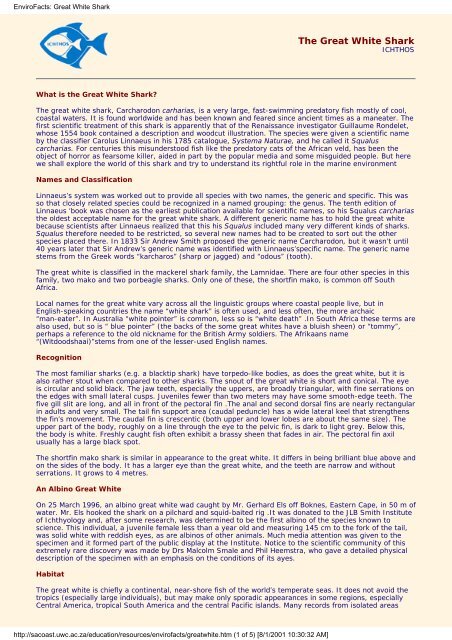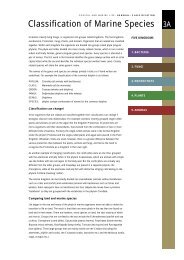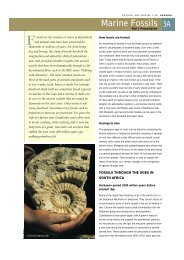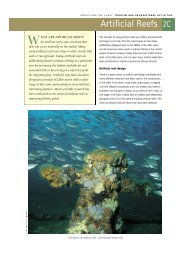EnviroFacts: Great White Shark - South African Coastal Information ...
EnviroFacts: Great White Shark - South African Coastal Information ...
EnviroFacts: Great White Shark - South African Coastal Information ...
Create successful ePaper yourself
Turn your PDF publications into a flip-book with our unique Google optimized e-Paper software.
<strong>EnviroFacts</strong>: <strong>Great</strong> <strong>White</strong> <strong>Shark</strong><br />
What is the <strong>Great</strong> <strong>White</strong> <strong>Shark</strong>?<br />
The <strong>Great</strong> <strong>White</strong> <strong>Shark</strong><br />
ICHTHOS<br />
The great white shark, Carcharodon carharias, is a very large, fast-swimming predatory fish mostly of cool,<br />
coastal waters. It is found worldwide and has been known and feared since ancient times as a maneater. The<br />
first scientific treatment of this shark is apparently that of the Renaissance investigator Guillaume Rondelet,<br />
whose 1554 book contained a description and woodcut illustration. The species were given a scientific name<br />
by the classifier Carolus Linnaeus in his 1785 catalogue, Systema Naturae, and he called it Squalus<br />
carcharias. For centuries this misunderstood fish like the predatory cats of the <strong>African</strong> veld, has been the<br />
object of horror as fearsome killer, aided in part by the popular media and some misguided people. But here<br />
we shall explore the world of this shark and try to understand its rightful role in the marine environment<br />
Names and Classification<br />
Linnaeus’s system was worked out to provide all species with two names, the generic and specific. This was<br />
so that closely related species could be recognized in a named grouping: the genus. The tenth edition of<br />
Linnaeus ‘book was chosen as the earliest publication available for scientific names, so his Squalus carcharias<br />
the oldest acceptable name for the great white shark. A different generic name has to hold the great white<br />
because scientists after Linnaeus realized that this his Squalus included many very different kinds of sharks.<br />
Squalus therefore needed to be restricted, so several new names had to be created to sort out the other<br />
species placed there. In 1833 Sir Andrew Smith proposed the generic name Carcharodon, but it wasn’t until<br />
40 years later that Sir Andrew’s generic name was identified with Linnaeus’specific name. The generic name<br />
stems from the Greek words “karcharos” (sharp or jagged) and “odous” (tooth).<br />
The great white is classified in the mackerel shark family, the Lamnidae. There are four other species in this<br />
family, two mako and two porbeagle sharks. Only one of these, the shortfin mako, is common off <strong>South</strong><br />
Africa.<br />
Local names for the great white vary across all the linguistic groups where coastal people live, but in<br />
English-speaking countries the name “white shark” is often used, and less often, the more archaic<br />
“man-eater”. In Australia “white pointer” is common, less so is “white death” .In <strong>South</strong> Africa these terms are<br />
also used, but so is “ blue pointer” (the backs of the some great whites have a bluish sheen) or “tommy”,<br />
perhaps a reference to the old nickname for the British Army soldiers. The Afrikaans name<br />
“(Witdoodshaai)”stems from one of the lesser-used English names.<br />
Recognition<br />
The most familiar sharks (e.g. a blacktip shark) have torpedo-like bodies, as does the great white, but it is<br />
also rather stout when compared to other sharks. The snout of the great white is short and conical. The eye<br />
is circular and solid black. The jaw teeth, especially the uppers, are broadly triangular, with fine serrations on<br />
the edges with small lateral cusps. Juveniles fewer than two meters may have some smooth-edge teeth. The<br />
five gill slit are long, and all in front of the pectoral fin .The anal and second dorsal fins are nearly rectangular<br />
in adults and very small. The tail fin support area (caudal peduncle) has a wide lateral keel that strengthens<br />
the fin’s movement. The caudal fin is crescentic (both upper and lower lobes are about the same size). The<br />
upper part of the body, roughly on a line through the eye to the pelvic fin, is dark to light grey. Below this,<br />
the body is white. Freshly caught fish often exhibit a brassy sheen that fades in air. The pectoral fin axil<br />
usually has a large black spot.<br />
The shortfin mako shark is similar in appearance to the great white. It differs in being brilliant blue above and<br />
on the sides of the body. It has a larger eye than the great white, and the teeth are narrow and without<br />
serrations. It grows to 4 metres.<br />
An Albino <strong>Great</strong> <strong>White</strong><br />
On 25 March 1996, an albino great white wad caught by Mr. Gerhard Els off Boknes, Eastern Cape, in 50 m of<br />
water. Mr. Els hooked the shark on a pilchard and squid-baited rig .It was donated to the JLB Smith Institute<br />
of Ichthyology and, after some research, was determined to be the first albino of the species known to<br />
science. This individual, a juvenile female less than a year old and measuring 145 cm to the fork of the tail,<br />
was solid white with reddish eyes, as are albinos of other animals. Much media attention was given to the<br />
specimen and it formed part of the public display at the Institute. Notice to the scientific community of this<br />
extremely rare discovery was made by Drs Malcolm Smale and Phil Heemstra, who gave a detailed physical<br />
description of the specimen with an emphasis on the conditions of its ayes.<br />
Habitat<br />
The great white is chiefly a continental, near-shore fish of the world’s temperate seas. It does not avoid the<br />
tropics (especially large individuals), but may make only sporadic appearances in some regions, especially<br />
Central America, tropical <strong>South</strong> America and the central Pacific islands. Many records from isolated areas<br />
http://sacoast.uwc.ac.za/education/resources/envirofacts/greatwhite.htm (1 of 5) [8/1/2001 10:30:32 AM]
<strong>EnviroFacts</strong>: <strong>Great</strong> <strong>White</strong> <strong>Shark</strong><br />
show that it is capable of ranging widely and even crossing ocean basins. <strong>Great</strong> whites stay mainly in<br />
near-surface waters, especially when hunting, but one has been caught on the bottom hook and line rig at a<br />
depth of 1280 metres.<br />
Known areas of abundance for the great white perhaps reflect its interaction with man (sport fisherman,<br />
beach bathers, scuba divers and surfers). These areas include California, the Mid-Atlantic States of the USA,<br />
southern Africa and eastern Australia, New Zealand and some Pacific islands.<br />
Relatives, Living and Fossil<br />
The living great white is one of five species classified in the genus Carharodon, but four are extinct.<br />
Researchers now believe an ancestral species, Carcharodan landanensis, arose in the Paleocene age (65-57<br />
million years ago) and gave rise to the two lineages at about the same time. The first, including the living<br />
great white, has intermediate fossil species that connect it to a relatively smaller C.landanenesis (2-3 metres<br />
in length). A second line, recognized as a separate genus, Carcharocles, by some researchers, include<br />
gigantic relations that can be traced back about 50 million years. The evolution of these huge sharks is<br />
characterized by increasing body size, and one may have lived up to fairly recent times.<br />
The modern great white evolved in Miocene times, about 20 million years ago. At the same times, two other<br />
much larger sister species that evolved from the second parallel lineage, called Carcharodon megalodon and<br />
C. angustidens, were present in the world’s sea. Teeth of the C.megalodon measuring 17 cm in length were<br />
found in<br />
Peru, and this indicates that it reached 13 metres or more, and weighed around 20 tons. This huge predator,<br />
at least at its largest sizes, probably fed mostly on large baleen whales. Some researchers postulate that it<br />
became extinct when the whales evolved a migratory behaviour into polar seas to feed on the abundant<br />
plankton there. This would have cut off the huge shark’s main food source for much of the year because they<br />
were not temperature adapted to follow the whales into icy seas.<br />
Fossilized teeth of the three species of Carcharodon have been found in southern Africa. Those of the modern<br />
great white, C. angustidens are known from KwaZulu-Natal near Uloa in a Lower Miocene deposit, about 15<br />
million years old. Teeth of the larger C. angustidens, measuring up to 15 cm, have been collected from the<br />
KwaZulu-Natal locality as well as the Eocene beds in the Eastern Cape and in Namibia. Another close lineage<br />
of Paleocene giant sharks without serrated teeth (Family Otodontidae) evolved alongside the Carcharodon<br />
species and gave rise to the living porbeagle sharks (genus Lamna).<br />
Size and Age<br />
Ageing sharks is not as easy task. This is mainly due to the fact that growth is related to nutrition (which<br />
may vary), geographical area, and that in some species males and females grow at different rates, which<br />
slows with age. Researchers have shown that calcified bands in the great white’s vertebrae mat reflect age,<br />
something like tree rings. On this basis, eastern Pacific great whites were aged at 13-14 years at a length of<br />
16 ft (4,75 m), while sharks from the North Atlantic were thought to be 20 years old at the same length.<br />
<strong>Great</strong> whites measure 109-129 cm at birth. Size and sexual maturity varies individually. Males mature at 3,5<br />
to 4,5 m and are about 9 years old. Females around 4,5 to 5 m and 12-14 years old. Presently it is unknown<br />
if males grow to a larger maximum size than females, though most of the largest (over 5 m) seen are<br />
females. Many incorrect maximum sizes have been reported over the past years; one at 36 feet (11 m) that<br />
persisted for decades was apparently a typographical error for 16 feet .The largest great white caught in<br />
recent years were not measured, but researchers have little doubt that one from Malta and another from<br />
<strong>South</strong> Australia were over 7 m total length These sharks would be approaching 30 years of age. A 6 m female<br />
recently caught in Gans Bay and examined by the <strong>Shark</strong> Research Centre, Cape Town, would have been<br />
about 22 years old, if one vertebral band equals to one year.<br />
Reproduction and Development<br />
Fertilization is internal in the great white and females give birth to live young (they are ovoviviparous).<br />
Courtship behaviour is unknown, but scientists think that scarred individuals suggest male-male aggression<br />
or that a male’s gentle biting of females may precede mating. After absorbing all their yolk the embryos<br />
begin to feed on eggs or even on other embryos, inside the mother. This is called intrauterine cannibalism<br />
and occurs in the great white’s relatives as well. Females with young are not documented, but larger females<br />
may bear more young (“pups”) than smaller ones, as in other sharks. One Australian female was found with<br />
11 pups. The gestation period is unknown, but with the large size at birth (above), it is likely to be around a<br />
year or longer. Dr Leonard Compago of the <strong>Shark</strong> Research Centre, Cape Town, has deduced an “average”<br />
female reproductive potential, bearing in mind number of variables and unknowns. With maturation at 5 m at<br />
the age of 15, with maximum size of 7.2 m at the age 30-31, and an average of nine pups every three years<br />
with a lag time of a year after giving birth before the next pregnancy, such as an “ average” female would<br />
produce 45 young up to a year before her death. However, owing to natural mortality, relative health and<br />
mate availability, most female great whites probably produce fewer young, especially in areas of heavy<br />
human impact.<br />
Some researchers believe that great whites are born to non-feeding, self-isolated females in coastal,<br />
warm-temperate seas and become adapted to wider temperature ranges as they grow. This would allow<br />
larger sharks to venture into open ocean areas, explaining their occurrence among the tropical mid-ocean<br />
islands. Scientists note that the known distribution of small great whites (two years old or less) and growth<br />
estimates suggest the young may be geographically restricted to areas of narrow temperature fluctuations<br />
until the supposed water temperature tolerance develops.<br />
http://sacoast.uwc.ac.za/education/resources/envirofacts/greatwhite.htm (2 of 5) [8/1/2001 10:30:32 AM]
<strong>EnviroFacts</strong>: <strong>Great</strong> <strong>White</strong> <strong>Shark</strong><br />
Food and Feeding Habits<br />
It is known, even among land-locked people the world over, the great white shark is a top predator .The<br />
sheer size, power and fearsome jaws of this creature demand such an observation. But surprisingly, great<br />
whites also scavenge carrion and garbage. Researchers have recorded prey items based on stomach contents<br />
as follows: bony fishes of many varieties and sizes of pilchards to sturgeons; Cartilaginous fishes, including<br />
other larger sharks and rays; sea turtles; birds; including gannets; gulls and penguins; marine mammals like<br />
dolphins, porpoise, seals and dead whales; invertebrates including abalone, other marine snails, squid,<br />
cuttlefish, starfish and crabs.<br />
Off seal colonies, great whites larger than 3 m evidently shift their diet from mostly fishes to seals. Jackass<br />
penguins are occasionally bitten by great white but these birds are seldom seen in their stomachs. Especially<br />
important feeding areas include Bird Island, Eastern Cape, and Dyer and Robben Islands, Western Cape.<br />
However, in tropical areas where the seals are rare or absent, great whites are perfectly capable of surviving<br />
on bony fishes, other sharks and marine mammals .It is important to note that whatever specialized<br />
predatory preference develops in one may not occur in other areas, as these large sharks are capable of<br />
ambushing, or otherwise catching, just about anything that swims in the sea.<br />
Large live seals must be among the great white’s most difficult prey. They are usually killed by a sudden<br />
burst of high speed that may throw the seal completely out of the water, with”bite” and “spit” behaviour. This<br />
action is viewed by scientists as a defensive kill; in other words, sharks are protecting themselves from the<br />
claws and teeth of an agitated, wounded animal. Penguins have been seen to be repeatedly tossed about like<br />
this off <strong>South</strong> Africa. This behaviour may not be part of an actual feeding repertoire, but may be more<br />
“playful” (except to the penguin!), or “ testing”, in the case of young sharks. Wounded, dying prey will then<br />
be circled by the shark until it is sufficiently weak, then consumed. In the context of the next section it is<br />
important to understand the great white’s marine mammal feeding strategy as outlined here.<br />
Attacks on Humans<br />
One of man’s deepest primal fears is that of being beaten alive by a wild animal. Perhaps the greatest part of<br />
the mystique of the great white concerns its long history of attacking people for just such a purpose.<br />
More attacks by great whites have been reported than any other shark. But, of all the shark attacks ever<br />
reported, 80 % have occurred in the tropics where great whites are rear. There, large hammerheads or<br />
requiem sharks are usually to blame. Indeed, Dr.Davies, former Director of the Oceanographic Research<br />
Institute, Durban, as long ago as 1964 (see References), credited seven species as dangerous in <strong>South</strong><br />
Africa. Still, more people drown or are injured or killed by bee stings, lightning, or snakebites every year than<br />
are attacked by sharks. Nevertheless, great whites are dangerous to human in the water, and some regions<br />
have reported more captures or attacks than others (see “Habitat”).<br />
American researchers documented 115 attacks by great whites worldwide from the 1926 to1991. Off <strong>South</strong><br />
Africa there were 29 attacks, six of them fatal. But a total of 89 shark attacks with 28 fatalities have been<br />
reported in S.A since 1940, so some of these are attributable to other species.<br />
Why are great whites dangerous? Contrary to some popular counts, they are dangerous simply because we,<br />
as land dwellers, do not naturally fit into the ocean environment where these large, fast predators view<br />
humans as potential prey. They may also react to people in the water as territory invaders that need to<br />
chased off, possibly explaining the may single-bite attacks attributed to great whites where victims have<br />
survived. Some sensational portrayals of sharks, particularly certain films and books of a by-gone era, have<br />
warped their natural predatory behaviour to instill horror in us by depicting hate-filled monsters bent on<br />
mindless destruction or revenge. Nothing could be further from the truth.<br />
Advice to Bathers, Surfers and Divers<br />
Even if great whites are simply part of the natural world and are not malicious, precautions need to be taken<br />
while in their world, just as wildlife tourists in our game parks take precautions against attack by predators<br />
such as lions. Below are some helpful guidelines we hope may serve to avoid a shark attack.<br />
1. Never swim alone, or wander far from a group of others in the water, thereby isolating yourself as a<br />
target. Many of our beaches have lifeguards or are protected by ant-shark nets and these areas<br />
should be favoured by batchers.<br />
2. Leave the water immediately if surfing or bathing and a large shark is seen. To scuba divers, many<br />
sharks will not recognize humans as prey, but may feel threatened by their presence. Leave the<br />
water if circled, bumped, or if a shark arches its back and twists from side to side in an exaggerated<br />
fashion. This is a pre-attack warming behavior. Do not, however, count on a shark to circle, pass<br />
close or threaten before it makes a direct charge.<br />
3. Blood is an attractant to sharks, whether from the fish, birds or mammals. Do not tow speared fish;<br />
remove them immediately and do not hang them in the water over the side of boats. Women should<br />
avoid the sea during their menstrual period. People have been attacked by sharks in knee-deep<br />
water.<br />
4. Avoid swimming or surfing in murky waters, such as off estuaries. Keep a watch out for shadows and<br />
movement around you while diving in reduced visibility. Leave the water if shoals of fish around you<br />
behave in an erratic manner, particularly near drop-offs or in channels.<br />
5. If diving from a boat, take care to observe the sea for a few minutes before entering the water.<br />
<strong>Shark</strong>s may surface and submerge repeatedly over the short intervals. Exit the water upon reaching<br />
the surface quickly, with minimal fanfare.<br />
http://sacoast.uwc.ac.za/education/resources/envirofacts/greatwhite.htm (3 of 5) [8/1/2001 10:30:32 AM]
<strong>EnviroFacts</strong>: <strong>Great</strong> <strong>White</strong> <strong>Shark</strong><br />
6.<br />
7.<br />
8.<br />
Avoid swimming far offshore at dusk or at night. Many sharks search for prey at these times. Night<br />
divers need to be particularly wary when diving in known shark-inhabited areas. Move slowly about<br />
and avoid flashing your touch around the water column needlessly.<br />
A popular myth is that if dolphins are around it is safe, since dolphins chase sharks away. Dolphins<br />
will not chase sharks unless protecting new-borns or if they feel threatened in some other way.<br />
Never molest or provoke a shark in any way, no matter how small or harmless it may appear. Ti is<br />
disrespectful of nature to do so; it may get you a nasty bite that could lead to greater trouble later.<br />
Treatment for Victims of <strong>Shark</strong> Attack<br />
Despite all precautions, in the eventuality of an attack there are several important things to know:<br />
1. It is most important to staunch the flow of blood as quickly as possible. A tourniquet to limbs may be<br />
needed between the wound and heart, taking care it is not too tight. Place compress bandages of<br />
anything soft and pliable at hand directly on wounds. Keep the victim immobile and as warm as<br />
possible. Summon medical emergency aid immediately, even for what may appear to be minor<br />
wound.<br />
2. For major injuries to surfers or bathers, lie the victim parallel to the sea on dry sand and raise the<br />
legs to promote blood flow to the head .Do not place a victim head down to the water’s edge. Help<br />
the victim to breathe if necessary.<br />
3. While awaiting medical aid, keep the victim conscious and calm by speaking reassuringly. Do not<br />
attempt to carry the victim off the beach or boat to a private vehicle to dash to hospital, as this may<br />
promote the onset of shock.<br />
4. Do not give any drink, especially of alcohol, as this may help lower the body’s core temperature and<br />
aid the onset of shock. Water may be used to wet the victim’s lips.<br />
Fishing for <strong>Great</strong> <strong>White</strong> <strong>Shark</strong>s<br />
Trophy fishing fir large sharks in vogue for decades, seriously so since the 1920s. In former years, avid<br />
fishermen caught sharks not only fir perceived personal glory (setting records), but also to combat the shark<br />
“ menace”, particularly off the USA, Australia and <strong>South</strong> Africa.<br />
In Australia after the second World War, catching great whites became an obsession to some, with Alf Dean<br />
setting the International Game Fish Association for the largest fish ever caught on rod an reel with a 1211 kg<br />
great white. Australian fishermen set chum slicks from boats using fish oil, blood or offal and often wait at<br />
the sea for days before a great white picks up the trails and rises to the occasion. Once a shark comes<br />
around the boat guided in by the slick, it is in an excited state and hooking it is little more effort than leading<br />
lambs to slaughter.<br />
In <strong>South</strong> Africa, trolling off the seal or penguin colonies was a more common practice until this became<br />
unlawful in 1991. On Durban’s <strong>South</strong> Pier, during, the heyday of the Union Whaling Company in the 1950s<br />
and ¢60s, large sharks were attracted into Durban harbor by blood. Shore fishermen devised a long pole and<br />
ladder-line rig to get large chunks of whale meat far into the harbor entrance and, after hooking a shark and<br />
playing it for hours, usually roped it up to the pier by its head. Most of these fish were Zambezi or tiger<br />
sharks, but many great whites were taken too.<br />
In 1947, Mr.L.M.Bowman, a Port Elizabeth businessman, initiated the annual Bowman trophy for the largest<br />
<strong>South</strong> <strong>African</strong> shark caught from land. From 1948 to 1966 every winner was a great white except for one.<br />
The record during this time was a great white weighing 755 kg landed in 1953.<br />
In the early days of the great white fishing very few, if any, were used for food. Their jaws were seldom cot<br />
out and prepared as trophies then, unlike after the release of the film, Jaws when large, well preserved great<br />
white jaws fetched large sums. As trophy hunting for great white is illegal now in <strong>South</strong> Africa, what is the<br />
point of fishing for them? For the expense involved there are cheaper ways to stock the freezer, so if not for<br />
trophies or food there seems to be no real reason to fish for these magnificent creatures anywhere in the<br />
world. In fact, conservation efforts are in place in <strong>South</strong> Africa to fully protect our great white populations.<br />
Marine Conservation: Sympathy for the Devil<br />
In a balance ecological community (ecosystem), whether on land, sea or air, top predators are numerically<br />
rare compared to their prey species. This applies to great whites, lions, polar bears, fish eagles and many<br />
other species near the top of food chains everywhere. <strong>Great</strong> whites are nowhere abundant, even relative to<br />
most other large sharks.<br />
Adding fishing pressure to a species whose population numbers are already low is worrisome. <strong>Shark</strong>s are<br />
especially susceptible to population crashes because their reproductive rate is low and it takes years to reach<br />
maturity (see Reproduction and Development above). Indeed, today <strong>South</strong> Australia, in areas made famous<br />
by filmmakers and scuba tour operators, such as Dangerous Reef, great whites have all but disappeared due<br />
to overfishing. Still, a network was recently set up there to report all great white occurrences to scientists in<br />
order to make management plans for the conservation of the species. <strong>South</strong> Australian conservation groups<br />
mounted a campaign to ban the targeting of great white for sport fishing, and chumming was outlawed. By<br />
the end o 1996 New <strong>South</strong> Wales’ and Tasmania’s Fisheries Regulations protected great whites.<br />
In <strong>South</strong> Africa, protection for the great white was a world first, thanks in large part to a long-term research<br />
programme organized by the <strong>Shark</strong> Research Centre, Cape Town. Researchers, conservation groups, sport<br />
http://sacoast.uwc.ac.za/education/resources/envirofacts/greatwhite.htm (4 of 5) [8/1/2001 10:30:32 AM]
<strong>EnviroFacts</strong>: <strong>Great</strong> <strong>White</strong> <strong>Shark</strong><br />
and commercial fishing interests and private citizens joined a debate that resulted in the 1991 Act that<br />
include a total ban on intentionally catching, molesting and commercially utilizing great whites (or parts like<br />
jaws), with heavy penalties for violators. Objectives to the Act came primarily from sport and commercial<br />
fishing interest that had profited from their capture (mainly the sale of meat and prepared jaws)<br />
Trophy fishing is not the only cause of great white population decline in Australia and <strong>South</strong> Africa. Also<br />
important is mortality caused by the commercial fishing industry, which is difficult to assess because of<br />
reporting problems, and the <strong>Shark</strong> Board (SB) nets. The SB. is a major known cause of great white<br />
mortalities in <strong>South</strong> Africa today. Between 22 to 61 great whites per year were taken in the anti-shark nets of<br />
KwaZulu-Natal between 1974 to 1988, with declining numbers in recent years. Live great whites have been<br />
released from SB nets since the late 1980s, however most sharks seen by SB staff in the nets died before it<br />
was possible to help them.<br />
Much emotional debate, as with that aimed at protecting the great white, has centered on the KwaZulu-Natal<br />
nets. Probably central to the debate is that the vast majority of sharks caught and killed have never been<br />
implicated in attacks on humans and most likely would not attack unless provoked. Reactions to the nets run<br />
gamut from keeping the nets up to protect the public (and foreign tourists!) at all costs from mindless killers,<br />
to a complete ban on the nets for all time, thus making people who venture into sharks territory take<br />
responsibility fir their actions.<br />
Recent technological studies made to address the carnage in anti-shark nets and protect swimmers and<br />
divers may soon be put into place. <strong>Shark</strong>s Board director Dr. Graeme Charter and researcher Mr. Norman<br />
Starkey developed a device called the “POD” (Protective Oceanic Device), the first successful electronic shark<br />
repellent known. The device produces an electromagnetic field that irritates sensitive organs set in head<br />
pores that sharks use to detect prey, called the Ampullae of Lorenzini. PODs worn by scuba divers are<br />
powered by a 90 volt power pack and work for up to 75 minutes. Devices for life jackets, paddle skis and<br />
surfboards will soon be planned. Until then, humans in the sea must remain wary so as not to be confused<br />
with the natural prey of such magnificent animals as the great white shark.<br />
Selected References Guide to <strong>Shark</strong>s for <strong>South</strong>ern Africa<br />
Budker, P. 1971. The life of <strong>Shark</strong>s. Weidnfield & Nicolson, London, 222pp.<br />
Cliff, G., S.F.J. Dudley & B. Davis. 1989. <strong>Shark</strong>s caught in the protective gill nets off Natal, <strong>South</strong> Africa .2.<br />
The great white shark, Carcharodon carcharias. S. Afr. J. Mar. Sci., 8:131-144.<br />
Compagno, L.J.V. 1981. Legend versus reality: the Jaws image and shark diversity. Oceanus 24 (4); 5-16<br />
-1984. <strong>Shark</strong>s of the World. FAO Species Catalogue, vol. 4,2 parts, Rome.<br />
-D.A. Ebert & M.J. Smale. 1989. Guide to the <strong>Shark</strong>s and Rays of <strong>South</strong>ern Africa. Struik Publishers, Cape<br />
Town, 160pp.<br />
Condon, T. (ed.). 1991. <strong>Great</strong> white <strong>Shark</strong>s - a Perspective. Underwater, no.17. Ihlane Publications, Durban:<br />
1-130.<br />
Cousteau, J. -Y. & P. Coustea. 1970. The <strong>Shark</strong>: Splendid Savage of the Sea. Doubleday & Co., Garden City,<br />
277 pp.<br />
Davies, D.H. 1964. About <strong>Shark</strong>s and <strong>Shark</strong> Attack. Shuter & Shooter, Pietermaritzburg, 237pp<br />
Ellis, R. & J.E. McCosker. 1991. <strong>Great</strong> <strong>White</strong> <strong>Shark</strong>. Stanford University Press, Harper Collins, New York,<br />
270pp.<br />
Sibley, G. et al (eds.). 1985. Biology of the white shark. Mem. So. Calif. Acad. Sci. 9, 150pp<br />
Smith, M.M. & P.C. Heemstra (eds.). 1986. Smiths’s Sea Fishes. Macmillan <strong>South</strong> Africa, Johannesburg,<br />
1047pp.<br />
Springer, V.G.& J.P Gold. 1989. <strong>Shark</strong>s in Questions. Smithsonian Institution Press, Washington, D.C.,<br />
187pp.<br />
Van der Elst, R. 1986. <strong>Shark</strong>s and Stingrays. Struik Publishers, Cape Town, 64 pp.<br />
Back to top Back to Resource index<br />
http://sacoast.uwc.ac.za/education/resources/envirofacts/greatwhite.htm (5 of 5) [8/1/2001 10:30:32 AM]









